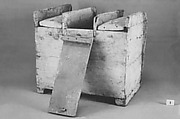Shabti Box and Shabtis of Henettawy B
Third Intermediate Period
This large shabti box of whitewashed sycomore wood belonged to a priestess named Henettawy, daughter of the High Priest of Amun Painedjem I. It was found near her coffin set (now in Cairo) in the chamber of a group tomb that contained the burials of at least 12 individuals.
Discovered lying on its side with its three lids tossed nearby, the box had been used to hold up the coffin of Nesitaset, another of the inhabitants of the tomb. The shabtis once stored inside had fallen out and were mixed in with debris on the floor near the head of Henettawy's coffins.
Henettawy had two different types of shabtis, which are small figurines meant to work for her if she were called on to perform manual labor in the afterlife. The largest are carelessly formed and painted, and are distinguished by their striped wigs. They come from several different molds, only one of which produced shabtis with breasts. The second type of shabti is smaller, with brilliant blue matte glaze; these have solid black hair and breasts.
Among the shabtis found in near the head of Henettawy’s coffins were fourteen "crude" examples with black cores and green surfaces. The inscriptions are illegible, but they were assigned tentatively to her.
Ideally, each individual would be buried with 401 shabtis, one for each day of the year plus supervisors. If the three types of shabtis assigned to Henettawy are added together, she would have had a full set.
Due to rights restrictions, this image cannot be enlarged, viewed at full screen, or downloaded.

